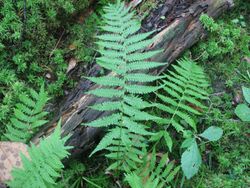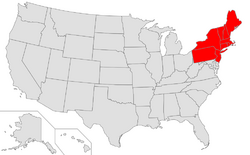Biology:Thelypteris simulata
| Thelypteris simulata | |
|---|---|

| |
| Thelypteris simulata in its natural habitat | |
| Scientific classification | |
| Kingdom: | Plantae |
| Clade: | Tracheophytes |
| Division: | Polypodiophyta |
| Class: | Polypodiopsida |
| Order: | Polypodiales |
| Suborder: | Aspleniineae |
| Family: | Thelypteridaceae |
| Genus: | Thelypteris |
| Species: | T. simulata
|
| Binomial name | |
| Thelypteris simulata (Davenp.) Nieuwl.
| |

| |
| Distribution of Thelypterus simulata in the Northeastern United States | |
Thelypteris simulata is a species of ferns native to the Northeastern United States. It is known by two common names: bog-fern and Massachusetts fern. It is often confused with the silvery spleenwort, New York fern, and the marsh fern due to similarities in shape and size.[1][2]
Description
Thelypteris simulata is bright green in color. The frond has some variation in shape, but it is around 61 cm (24 in) long, and its stalk is long and slender at 20.3 cm (8 in).[2] The stalks are thin and slightly scaly, or hairy. The upwards portion is yellow-green in color, and the base is a light brown color.
The leaves are monomorphic and pinnately compounded; they can be between 10–40 cm (3.9-15.7 in) long and 7.6-15.3 cm (3–6 in) wide.[2][3][4] The branching pattern appears to be opposite, but upon close observation it is clearly a slight alternate pattern. The leaf veins are for the most part unbranched, although some branching can be seen towards the lower part of the blade.[1]
Thelypteris simulata produces both fertile and sterile leaflets. The leaflets are twice-compounded and divided mid-vein into between fifteen to eighteen lobes. They are oblong in shape and become narrower near the axis, noticeably more so near the base.[2] The majority of the leaflets are erect, but the bottom pair point downward. They are around 25–80 cm (9.8-31.5 in) long.[3] The fertile and sterile leaflets are similar in shape in size, but the fertile leaflets tend to be slightly longer than the sterile leaflets. Sori (singular sorus), are found on the underside of the leaflets, and they are round in shape.The indusium is a pale tan color and is shaped like a kidney.[2][4]
The rhizome is slender and black with some scales. It spreads out far and has a lot of branching. Older roots are short, black, thin, and wiry. There are many young, hairlike rootlets.[2]
Distribution
Thelypteris simulata is a terrestrial plant native to the Northeastern United States. It is local to Maine, New Hampshire, Rhode Island, Connecticut, Vermont, and Massachusetts, and there have been some sightings in parts of Canada around the provinces of Ontario and Quebec.[4] There was an isolated patch discovered in Southwestern Wisconsin, far outside its expected distribution.[3] Generally speaking, this plant is uncommon.
Ecology
Thelypteris simulata grows in shaded, marshy wetlands and bog areas such as cedar, spruce, larch, and sphagnum swamps.[3][2] It likes to grow among bryophytes, which protect the plant from the sun and provide it with a shady area.[4] It prefers and is most often found in moist, acidic soil that is soft and spongy.[5]
Growth
Thelypteris simulata is a forb/herb perennial.[6] The shoot system sprouts up from a rhizome, which is typically an underground root, but is sometimes found at the ground level. The leaves die and fall off during the wintertime.[4] Spores are produced in the summertime.[1]
History
Thelypteris simulata was first discovered in 1894.[2] One way it was located was from the sweet-smelling fragrance it emits.[5] Since it has a lot of similarities to the marsh fern, New York fern, and silvery spleenwort, people often fail to notice its existence, and have difficulty distinguishing it from the other similar ferns. There is still some confusion today, as this species is relatively uncommon and its shape can be variable.
References
- ↑ 1.0 1.1 1.2 Wiley, Farida (1973). Ferns of Northeastern United States. New York, New York: Dover Publications, Inc.. pp. 43.
- ↑ 2.0 2.1 2.2 2.3 2.4 2.5 2.6 2.7 Cobb, Boughton (1956). A Field Guide to the Ferns. Cambridge, Massachusetts: The Riverside Press. pp. 88–89.
- ↑ 3.0 3.1 3.2 3.3 Nieuwland, Amer (1910). "Thelypteris simulata". http://www.efloras.org/florataxon.aspx?flora_id=1&taxon_id=233501304.
- ↑ 4.0 4.1 4.2 4.3 4.4 New England Wild Flower Society (n.d.). "Parathelypteris simulata". https://gobotany.newenglandwild.org/species/parathelypteris/simulata/.
- ↑ 5.0 5.1 Corne, F. E. (1925). "Fragrant Massachusetts Fern". American Fern Journal 15: 21–22.
- ↑ United States Department of Agriculture, Natural Resources Conservation Service (n.d.). "Plants Profile for Thelypteris simulata (bog fern)". https://plants.usda.gov/core/profile?symbol=THSI2.
Wikidata ☰ Q15322601 entry


